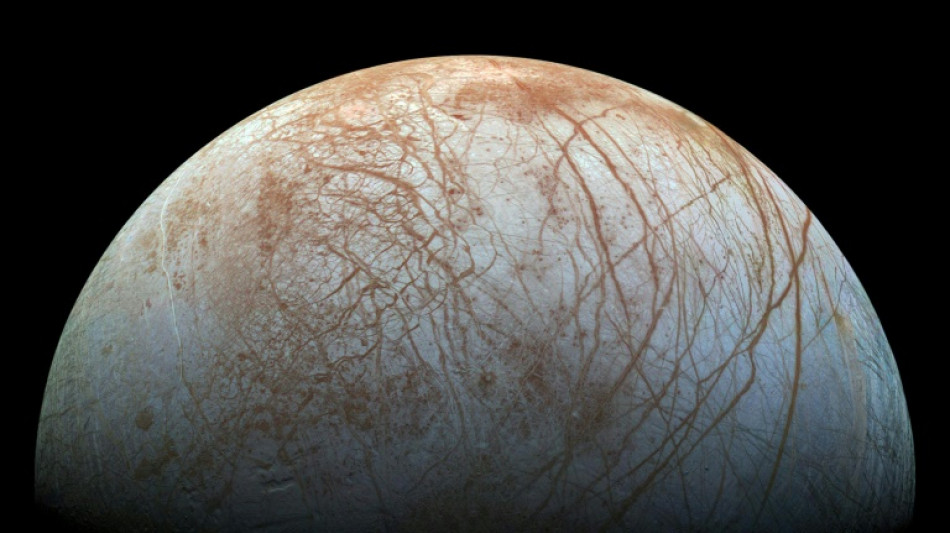
-
 Europe increasingly 'vulnerable' to shocks: ECB chief
Europe increasingly 'vulnerable' to shocks: ECB chief
-
Slot says Liverpool will never use Jota grief as 'excuse' for poor form

-
 Aussie Wilson 'devastated' after Gordon ruled out of France Test
Aussie Wilson 'devastated' after Gordon ruled out of France Test
-
Ken Follett: 'There can't be boring bits in my books'

-
 Wales rugby turmoil here to stay as nostalgia battles financial reality
Wales rugby turmoil here to stay as nostalgia battles financial reality
-
Frida Kahlo painting sells for $54.7 mn in record for female artist

-
 Thailand's last hunter-gatherers seek land rights
Thailand's last hunter-gatherers seek land rights
-
Tech firms lead stock rout as AI bubble fears linger

-
 World's biggest nuclear plant edges closer to restart
World's biggest nuclear plant edges closer to restart
-
India's injured Gill out of must-win second South Africa Test

-
 Japan's eel delicacy faces global conservation pressure
Japan's eel delicacy faces global conservation pressure
-
Starc takes seven as England rolled for 172 in Ashes opener

-
 New York's incoming leftist mayor to face off with Trump
New York's incoming leftist mayor to face off with Trump
-
Fossil fuel showdown looms on UN climate summit's final day

-
 Japan's Takaichi insists $135 bn stimulus fiscally 'responsible'
Japan's Takaichi insists $135 bn stimulus fiscally 'responsible'
-
Norris tops red-flagged second practice for Las Vegas GP

-
 Miss Mexico wins Miss Universe contest after host insult drama
Miss Mexico wins Miss Universe contest after host insult drama
-
Texans sack Allen eight times to beat Bills 23-19

-
 Rusty France face 'tired' Australia at end of torrid year
Rusty France face 'tired' Australia at end of torrid year
-
Dortmund host new nemesis Stuttgart with title hopes slipping away

-
 Munster tragedy 'life-changing' for Springbok coach Erasmus
Munster tragedy 'life-changing' for Springbok coach Erasmus
-
Starc on fire as England slump to 105-4 at lunch in Ashes opener

-
 Taiwan issues 'crisis' guide on preparing for disasters, Chinese attack
Taiwan issues 'crisis' guide on preparing for disasters, Chinese attack
-
Washington's abandoned embassies have stories to tell

-
 Maxey powers Sixers over Bucks as Spurs beat Hawks
Maxey powers Sixers over Bucks as Spurs beat Hawks
-
Barca hoping Camp Nou return can spark Liga title defence

-
 All Blacks bid to bounce back for season-ender against struggling Wales
All Blacks bid to bounce back for season-ender against struggling Wales
-
Pogba set for long-awaited comeback as Ligue 1 returns

-
 Inter and Milan in early Scudetto clash as Napoli attempt to bounce back
Inter and Milan in early Scudetto clash as Napoli attempt to bounce back
-
How England revived their rugby fortunes

-
 A big deal: Robert Therrien's huge sculptures on show in LA
A big deal: Robert Therrien's huge sculptures on show in LA
-
In U-turn, US rights report to track gender changes, DEI

-
 Afghanistan seeks new trade routes as Pakistan ties sour
Afghanistan seeks new trade routes as Pakistan ties sour
-
Iranian director Jafar Panahi ramps up French Oscars campaign

-
 Cuba battles virus outbreak despite shortages of food, medicine
Cuba battles virus outbreak despite shortages of food, medicine
-
30-plus nations oppose COP30 draft over fossil fuel omission: Colombia

-
 Tech firms lead Asian stock rout as AI bubble fears linger
Tech firms lead Asian stock rout as AI bubble fears linger
-
Ukraine would give Russia chunk of territory under 28-point US plan

-
 England win toss, bat in first Ashes Test
England win toss, bat in first Ashes Test
-
Teen saving India's ponds says everyone can be a leader

-
 Frida Kahlo painting auctions for $54.6 mn, record for woman artist
Frida Kahlo painting auctions for $54.6 mn, record for woman artist
-
Arsenal brace for Spurs clash without Gabriel, Man City in pursuit

-
 Scramble for Sudan's resources fuels brutal civil war
Scramble for Sudan's resources fuels brutal civil war
-
Livestream giant Twitch to ban under-16s in Australia

-
 Ukraine would cede Donbas to Russia under 28-point US plan
Ukraine would cede Donbas to Russia under 28-point US plan
-
Spain and Germany reach Davis Cup semi-finals

-
 'Black Panther' star Chadwick Boseman gets Hollywood star
'Black Panther' star Chadwick Boseman gets Hollywood star
-
Inningz Wealth Circle Introduces New AI Voice Mentor Inspired by Isaac Sinclair's Direction

-
 Battery X Metals Announces Corporate Awareness Engagement
Battery X Metals Announces Corporate Awareness Engagement
-
Trump plans massive expansion of offshore oil drilling


Water on Jupiter's moon closer to surface than thought: study
Ridges that criss-cross the icy surface of Jupiter's moon Europa indicate there are shallow pockets of water beneath, boosting hopes in the search for extra-terrestrial life, scientists said Tuesday.
Europa has long been a candidate for finding life in our solar system due to its vast ocean, which is widely thought to contain liquid water -- a key ingredient for life.
There is a problem: the ocean is predicted to be buried 25-30 kilometres (15-17 miles) beneath the moon's icy shell.
However water could be closer to the surface than previously thought, according to new research published in the journal Nature Communications.
The finding came partly by chance, when geophysicists studying an ice sheet in Greenland watched a presentation about Europa and spotted a feature they recognised.
"We were working on something totally different related to climate change and its impact on the surface of Greenland when we saw these tiny double ridges," said the study's senior author Dustin Schroeder, a geophysics professor at Stanford University.
They realised that the M-shaped icy crests on Greenland looked like smaller versions of double ridges on Europa, which are the most common feature on the moon.
Europa's double ridges were first photographed by NASA's Galileo spacecraft in the 1990s, but little was known about how they were formed.
The scientists used ice-penetrating radar to observe that Greenland's ridges were formed when water pockets around 30 metres (100 feet) below the ice sheet's surface refroze and fractured.
"This is particularly exciting, because scientists have been studying double ridges on Europa for more than 20 years and have not yet come to a definitive answer for how double ridges form," said lead study author Riley Culberg, an electrical engineering PhD student at Stanford.
"This was the first time that we were able to watch something similar happen on Earth and actually observe the subsurface processes that led to the formation of the ridges," he told AFP.
"If Europa's double ridges also form in this way, it suggests that shallow water pockets must have been (or maybe still are) extremely common."
- 'Life has a shot' -
Europa's water pockets could be buried five kilometres beneath the moon’s ice shell -- but that would still be much easier to access than the far deeper ocean.
"Particularly if such water pockets form because ocean water was forced up through fractures into the ice shell, then it's possible that they would preserve evidence of any life in the ocean itself," Culberg said.
Water closer to the surface would also contain "interesting chemicals" from space and other moons, increasing the "possibility that life has a shot," Schroeder said in a statement.
We may not have too long to wait to find out more.
NASA's Europa Clipper mission, scheduled to launch in 2024 and arrive in 2030, will have ice-penetrating radar equipment similar to that used by the scientists studying Greenland's double ridges.
The spacecraft is unlikely to find definitive proof of life because it will not land on Europa, instead flying by and analysing it.
But hopes remain high. The moon's ocean is predicted to have more water than all of Earth's seas combined, according to the Europa Clipper's website.
"If there is life in Europa, it almost certainly was completely independent from the origin of life on Earth... that would mean the origin of life must be pretty easy throughout the galaxy and beyond," project scientist Robert Pappalardo said on the website.
S.F.Warren--AMWN

